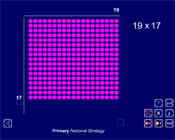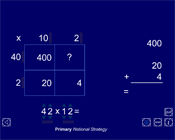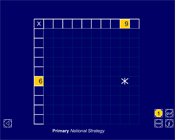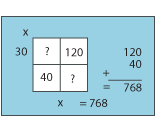Teaching guidance
This teaching guidance document suggests some of the key vocabulary, models, images and practical equipment that children should experience and be able to use. It also includes some teaching tips to provide a few starting points for ways of supporting children with this area of mathematics.
 Can I use a written method to multiply? - teaching guidance | 65KB
Can I use a written method to multiply? - teaching guidance | 65KB 
Consolidation and practice
These resources are to support children in guided or independent work. Roll over the highlighted resources for a description.
Multiarray

This interactive teaching program (ITP) is an ICT-based tool to support the exploration of multiplication. Multiarray ITP allows the child or teacher to uncover a section of an array of counters, dropping on grid lines to explore methods of multiplication.
Multiplication grid

This interactive teaching program (ITP) is an ICT-based tool to support the exploration of multiplication. Multiplication grid ITP allows the child or teacher to demonstrate the grid method of multiplication for whole and decimal numbers. The ITP can be used to develop children's abilities to apply their knowledge of number facts and to deduce and reason, when finding missing component numbers.
Multiplication board

This interactive teaching program (ITP) is an ICT-based tool to support the exploration of multiplication and division facts. Multiplication board ITP allows the child or teacher to represent the product of two numbers as an array, displaying the product and factors.
Opportunities to use and apply
Possible contexts include:
- Problem solving, e.g. Here is a multiplication calculation with some missing numbers.

What is the calculation? Explain how you worked it out.
- Measurement, e.g.
- What is the area of a field 27 metres by 35 metres?
- I have 16 boxes each weighing 20.5 kg. What is their total weight?
Confirming learning
Ask probing questions such as:
- How would partitioning help you calculate 237 × 6?
- What could you do to help you calculate 2.3 × 9?
- Show me your method for solving this problem:
‘What is the total mass of 235 screws each weighing 6 grams?’ What approximations could you make?
Explain your working.
- Create some multiplication calculations with incorrect, but reasonable answers, e.g. 34 × 51 = 1751. Ask the children to estimate roughly what the answer should be, and then identify what errors might have been made.
 Calculating
Calculating



